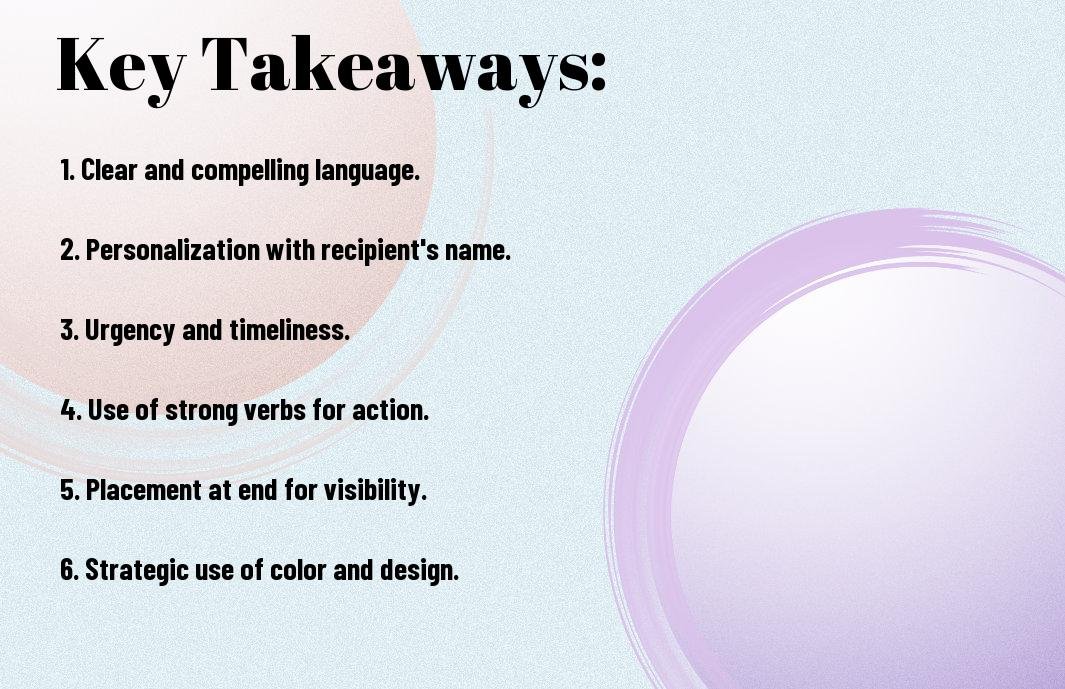Action-oriented email CTAs are important to prompt recipients to take the desired action. A compelling Call-to-Action (CTA) can significantly impact the success of an email campaign. In this blog post, we will explore examples of effective email CTAs that have been proven to drive action and engage readers. These real-life illustrations will demonstrate the power of a well-crafted CTA in generating conversions and achieving campaign goals. By analyzing what makes these CTAs successful, you can apply similar strategies to enhance your own email marketing efforts and boost engagement.
Key Takeaways:
- Clear and specific language: Use concise and direct language in your email CTAs to clearly communicate the action you want the reader to take.
- Strong verbs: Use action-oriented verbs like “shop now,” “sign up,” or “download” to prompt immediate response from the reader.
- Create a sense of urgency: Incorporate phrases like “limited time offer” or “act now” to motivate readers to take action quickly.
- Personalization: Tailor your CTAs to resonate with your target audience and make them feel like the action is personalized to their needs.
- Strategic placement: Position your CTAs prominently in your email, ensuring they stand out visually and are easily accessible for readers to click on.


Crafting Your CTA
Language That Motivates
To effectively drive action with your email CTA, the language you use must be compelling and urgent. Phrases such as “Act Now,” “Limited Time Offer,” and “Don’t Miss Out” create a sense of urgency that encourages recipients to take immediate action. Using active verbs like “Shop,” “Discover,” or “Join” also prompts engagement and drives conversions.
Design Elements That Stand Out
To make your CTA stand out in an email, consider using bold colors that contrast with the background and a prominent placement within the email layout. Button CTAs tend to perform better than hyperlinks because they are easier to spot and click on. Additionally, incorporating white space around the CTA can draw the recipient’s eye towards it and make it more clickable.
This combination of strategic design elements can significantly impact the effectiveness of your email CTA and ultimately drive the desired action from your audience. By focusing on creating a visually appealing and attention-grabbing CTA, you can increase click-through rates and achieve your email marketing goals more effectively.
Placement Strategies for CTAs
Ideal Placement Within an Email
Keep your Call-to-Action (CTA) visible and strategically placed within your email to ensure it grabs the reader’s attention. The ideal placement for a CTA is typically towards the top of the email, above the fold, where it is easily visible without the need for scrolling. Make sure the CTA stands out by using contrasting colors, bold fonts, or buttons to drive action.
CTAs: Balancing Multiple CTAs
When including multiple CTAs in your email, it’s crucial to strike a balance between providing options and overwhelming the recipient. Identify the primary goal of your email and focus on highlighting that CTA prominently, while supporting CTAs can be placed below. Ensure a clear hierarchy in your CTAs, with the most important action standing out the most prominently. Utilize design elements like spacing, color, and size to differentiate between CTAs.

Types of Email CTAs
After conducting extensive research on the subject, it is evident that email CTAs can be divided into two main categories: Direct Action CTAs and Informational or Soft CTAs. Knowing how to use these effectively can significantly impact the success of your email marketing campaigns.
Direct Action CTAs
CTAs in this category are straightforward and action-oriented, prompting recipients to take immediate steps such as ‘Shop Now’ or ‘Sign Up Today’. These CTAs are designed to drive conversions and lead to direct sales or conversions. They are crucial for generating instant results and encouraging users to make a purchase or sign up for a service.
Informational or Soft CTAs
CTAs in this category are more subtle and focus on providing information or guiding recipients towards further engagement without a direct sales pitch. They could include ‘Learn More’ or ‘Explore Our Blog’. These CTAs aim to nurture leads and build relationships with the audience by offering valuable content or resources.
It is important to strike a balance between the two types of CTAs in your email campaigns to cater to different segments of your audience and achieve diverse goals.

Measuring CTA Success
Key Metrics to Track
Success in measuring the effectiveness of email CTAs lies in tracking key metrics. The crucial metrics to monitor include click-through rates (CTRs), conversion rates, bounce rates, and overall engagement. By analyzing these metrics, marketers can determine the impact of their CTAs and make data-driven decisions for future campaigns.
Iterating for Improved Performance
Success in email marketing hinges on constant optimization and iteration for improved performance. By testing different CTAs, wording, placement, and design elements, marketers can pinpoint what resonates best with their audience. A/B testing is a powerful tool to identify what drives the most action and refine strategies accordingly.
Understanding and interpreting these metrics is crucial for driving better results. Marketers must pay attention to trends and patterns in the data to continuously enhance the effectiveness of their email CTAs. By staying informed and willing to adapt based on insights, marketers can create more compelling calls-to-action that drive action and boost engagement.
Summing up
The examples of effective email CTAs highlighted in this article demonstrate the power of a compelling call-to-action in driving action and engagement from recipients. By incorporating elements such as clear language, urgency, personalization, and relevance, marketers can create CTAs that prompt users to take the desired action. Whether it’s encouraging a purchase, signing up for a webinar, or engaging with content, a well-crafted CTA can make a significant impact on the success of an email marketing campaign. Remember to continuously test and optimize your CTAs to maximize their effectiveness and drive desired outcomes.
FAQ
Q: Why are email CTAs important?
A: Email CTAs are important because they prompt your readers to take specific actions, such as making a purchase, signing up for a webinar, or downloading a resource. They help drive conversions and engagement within your email campaigns.
Q: What makes an email CTA effective?
A: An effective email CTA is clear, specific, and compelling. It should use action-oriented language, be visually prominent, and align with the content of the email. It should also create a sense of urgency or offer a benefit to the reader.
Q: How can I create a compelling email CTA?
A: To create a compelling email CTA, start by understanding your audience and their needs. Use concise and persuasive language that clearly communicates the value proposition. Make sure the CTA stands out visually with contrasting colors and sufficient white space.
Q: What are some examples of effective email CTAs?
A: Examples of effective email CTAs include “Shop Now,” “Download Your Free Guide,” “Register for the Webinar,” “Start Your Free Trial Today,” and “Get 50% Off Now.” These CTAs are clear, action-oriented, and offer a specific benefit to the reader.
Q: How can I test the effectiveness of my email CTAs?
A: You can test the effectiveness of your email CTAs by conducting A/B split tests. Create variations of your CTA in terms of language, design, placement, or color, and send them to different segments of your audience. Analyze the results to see which CTA performs best and optimize accordingly.
Recent Posts
Affiliate Offer Goldmine: How I Find Profitable Affiliate Offers
Affiliate marketing can be overwhelming if you rely on guesswork or follow generic advice. I've discovered that most beginners waste time promoting overcrowded, untested, or unprofitable offers. In...
As an affiliate marketer, you know how crucial it is to create engaging and effective blog posts that drive traffic and generate sales. But coming up with fresh and profitable ideas can be a...

